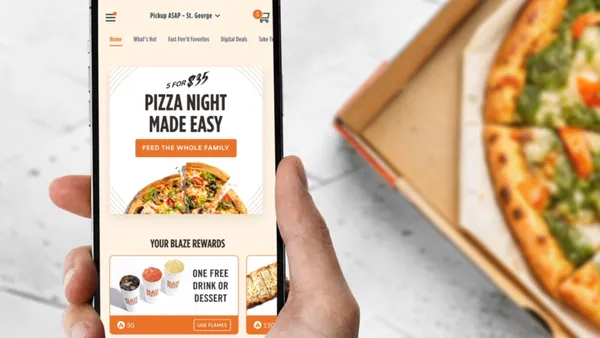Dive Brief:
- Sweetgreen plans for all of its new restaurants within the next five years to be automated through its Infinite Kitchen system, CEO Jonathan Neman told investors at William Blair’s Growth Stock Conference on Wednesday. Existing units will eventually be retrofitted with the automated makeline.
- Suburban development is another cornerstone of the company’s growth strategy, Neman said. A majority of its restaurants are now located in suburban areas.
- Sweetgreen’s Infinite Kitchen first launched in Naperville, Illinois, this spring. The chain’s focus on this system and comes as restaurants, equipment makers and software companies work to boost labor productivity.
Dive Insight:
Neman said that while the brand will eventually have an Infinite Kitchen in every unit, its near term concentration is on new builds.
“The focus for us will be much more on new restaurants just because of the capital-intensive nature of retrofitting floors,” Neman said. “We will test a retrofit soon to understand what that does. But one of the advantages Sweetgreen has is that most of our growth is in front of us, not behind us.”
The Infinite Kitchen does not automate prep or the final assembly of the salads, Neman said, leaving the beginning and end of production in human hands. The Infinite Kitchen dispenses salad ingredients into a bowl, but workers still add final toppings, the company said when it first announced the makeline.
Sweetgreen first opened in Washington, D.C. and its early expansion concentrated on similarly dense cities and central business districts. But its suburban units are key to growth, Neman said, and now outperform many older, urban stores. The company’s shift towards suburbs has been accompanied by a focus on different store models, including its first drive-thru, which opened in November 2022.
“Today, our suburban stores have actually, from an AUV perspective, slightly exceeded our urban stores,” Neman said. “Over 50% of the stores are suburban and most of the pipeline going forward is also suburban.”
Still, Neman said, the brand’s urban store portfolio continues to perform well, despite lunch hours lagging behind pre-pandemic numbers.
Sweetgreen’s strategy for automating much of its salad production was part of a push to reach positive EBITDA in 2024 and improve restaurant level margins to over 20%, Sharon Zackfia, a William Blair analyst, wrote in a report emailed to Restaurant Dive.
“With less labor intensity and greater job satisfaction so far, we believe the Infinite Kitchen has the potential to structurally change Sweetgreen’s labor model, as roughly half of variable labor stems from assembly,” Zackfia wrote.
Sweetgreen’s efforts to improve profitability have extended from store design changes and automation to the launch of a national loyalty program in April. Zackfia wrote that the Sweetgreen’s loyalty program has boosted customer frequency beyond management’s expectations. Zackfia predicted Sweetgreen had the potential to reach 900 units, $3 billion in revenue and $400 million in EBITDA within the next decade.
Still, Sweetgreen’s profitability challenges have cast a shadow on its stock price, which is down almost 80% since its IPO in 2021, according to Google Finance. Sweetgreen’s struggle to reach profitability prompted David Trainer, CEO of New Constructs, to warn against investing with other unprofitable fast casual concepts like Cava, which issued its IPO earlier this week.














